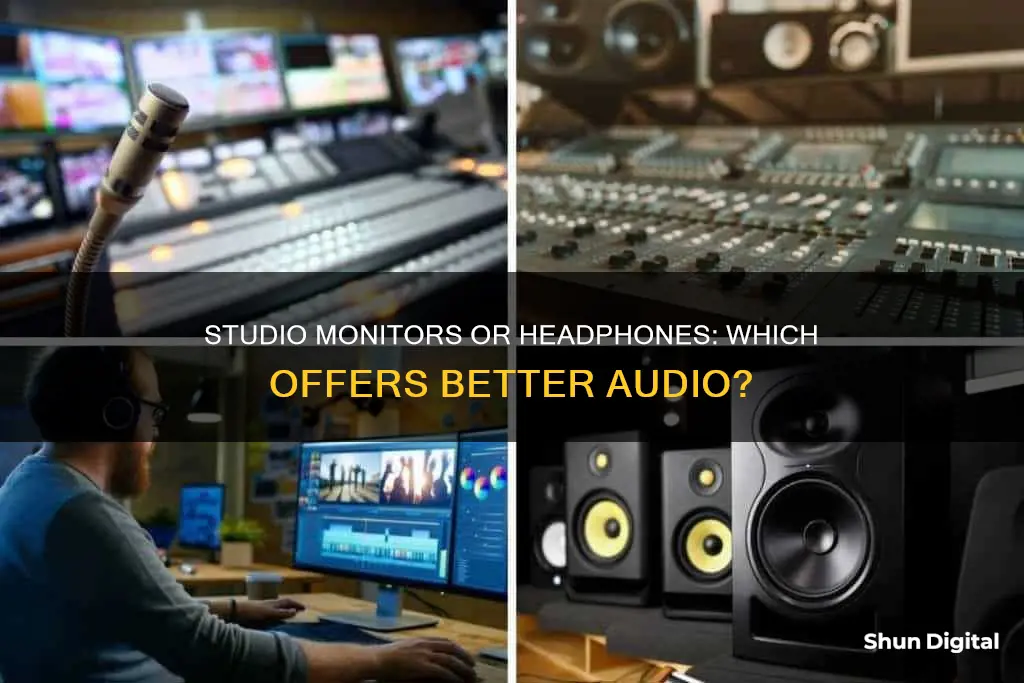
Studio monitors and studio headphones both have their advantages and disadvantages. Studio monitors are built to provide an accurate representation of audio, allowing musicians to hear their work as it truly sounds. They offer a flatter frequency response, more separation, and eliminate ear fatigue. On the other hand, studio headphones are more convenient and portable, allowing users to mix music without disturbing others. They can also provide a more intimate listening experience with increased bass perception. The ideal scenario is to have both options available to leverage their respective benefits and make better mixing decisions.
What You'll Learn
- Studio monitors offer a more authentic and natural-sounding representation of your tracks
- Studio headphones are more practical for those without a dedicated mix room
- Studio monitors are better for sharing music with others
- Studio headphones are more practical for those with thin walls and close neighbours
- Studio monitors are better for longer sessions

Studio monitors offer a more authentic and natural-sounding representation of your tracks
The human auditory system perceives sound differently when listening on headphones. Both ears are fed their own channels at precisely the same time, resulting in a sound that seems to come from inside the middle of your head, rather than in front of you. This results in a perception of the stereo image that is a lot different from that of monitors. Panned instruments may seem more widely spaced, and effects like reverb and delay may appear deeper and wider.
While headphones can be a great alternative for those without access to a studio, studio monitors provide a more authentic listening experience.
Unlocking Monitor: Removing OSD Lock with Easy Steps
You may want to see also

Studio headphones are more practical for those without a dedicated mix room
One of the advantages of studio headphones is their ability to provide a detailed listening experience. They are excellent for identifying issues like unwanted distortion, clipping, and clicks. With headphones, you can often notice nuances in the tracks that might be missed with regular monitors, making them particularly useful for addressing tonal clashes, vocal timing problems, or pitching issues.
Another benefit of studio headphones is their convenience and privacy. You can use them day or night without disturbing your neighbours, which is not always possible with monitor speakers. This flexibility allows you to work on your mixes whenever inspiration strikes, without worrying about noise complaints.
Additionally, studio headphones are generally more affordable than studio monitors, making them a cost-effective option for those on a budget. They also eliminate the need for acoustic treatment, as they are less susceptible to the acoustic challenges of the room. This makes them a practical choice for those who do not have the space or resources for a dedicated mix room.
While studio headphones offer numerous advantages, it is important to recognise their limitations. They may not provide an accurate representation of the low-end frequencies, and panning, reverb, and delay effects can be more pronounced, requiring adjustments to ensure a consistent listening experience across different playback systems.
Adjusting Text Size: Upgrading Monitors, Maintaining Comfortable Viewing
You may want to see also

Studio monitors are better for sharing music with others
Studio monitors physically push sound waves around the room. These waves are reflected and absorbed by objects in the room, and the shifts in timing and phase provide our brain with volume and directional information that feels natural and organic. This is a more familiar and shared experience than the individualised sound of headphones.
With studio monitors, as you turn your head and move around the room, you will hear different frequencies. You can leave the sweet listening spot temporarily to hear some details by turning your head left and right, or up and down. This is something we do instinctively.
Listening on speakers is a lot more exciting because you are in the sound. When you move around, the sound changes accordingly, and the low-frequency sound waves hit your body so you are not just hearing the sound but also feeling it. This feeling part could be emulated with a properly set-up bass transducer, but this is an additional expense.
Studio monitors are also a more comfortable option for extended listening. Even the most comfortable headphones can get tiring, with the constant pressure on or around the ears eventually taking its toll and demanding regular breaks.
Yaris Blind Spot Monitoring: Is It Worth the Hype?
You may want to see also

Studio headphones are more practical for those with thin walls and close neighbours
Studio headphones are a more practical option for those with thin walls and close neighbours. Studio monitors are loudspeakers that require a certain volume to achieve a balanced representation of all frequencies. This means that they may not be suitable for those with thin walls and close neighbours, as the noise could disturb others. Studio headphones, on the other hand, allow for a more private listening experience, making them ideal for those who need to keep the volume down.
Studio headphones can also be useful for spotting and homing in on details such as unwanted distortion, clipping, and clicks. They can provide a more intimate listening experience, allowing you to focus on the intricacies of the mix. This can be especially beneficial for those with less-than-ideal acoustics in their mixing environment, as headphones can cut out distracting room reflections and ambient noise.
Additionally, studio headphones offer flexibility and convenience. They are generally more affordable and easier to set up than studio monitors, making them a cost-effective option for those on a budget or with limited space. Headphones also eliminate the need for acoustic treatment, as they are less susceptible to the acoustic challenges posed by thin walls and small spaces.
While studio monitors provide a natural and authentic listening experience, studio headphones offer practicality and privacy. For those with thin walls and close neighbours, studio headphones are a more considerate and discreet option. They allow you to mix and master your audio without disturbing others, making them a sensible choice for late-night sessions or when volume needs to be kept to a minimum.
Disassembling LG LCD Monitors: A Step-by-Step Guide
You may want to see also

Studio monitors are better for longer sessions
Additionally, studio monitors allow for a more exciting listening experience. As you move around the room, you will hear different frequencies, and the low-frequency sound waves can be felt as well as heard. This creates a more immersive experience, as you are not just hearing the sound but also feeling it.
Studio monitors are also better for sharing your music with others. While headphones can be used to listen to music individually, monitors allow for a more social and fun experience.
Furthermore, studio monitors are often a more comfortable option for extended periods. Headphones apply constant pressure on or around the ears, which can become tiring over time. This can impact your ability to make objective decisions about your mix.
Overall, while both options have their advantages, studio monitors are a better choice for longer sessions due to their ability to provide a more natural, exciting, and comfortable listening experience.
Blind Spot Monitor: Standard or Optional on E-Class?
You may want to see also
Frequently asked questions
Studio monitors provide the most authentic and natural-sounding representation of your tracks. They are also how we are most used to hearing music, which makes them the most natural choice for mixing for the majority of people.
Studio monitors can be impractical if you have thin walls and unsympathetic neighbours as you need to drive them around 80dB SPL for the most balanced representation of all frequencies.
Studio headphones are great for spotting and homing in on details such as unwanted distortion, clipping and clicks. They are also a good option if you have thin walls and sensitive neighbours as you can listen to them at a reasonable volume, day or night, without bothering others.
Studio headphones can lack bass response and give an inaccurate picture of your mix. They can also be uncomfortable as the constant pressure on or around the ears eventually takes its toll and demands a break.







